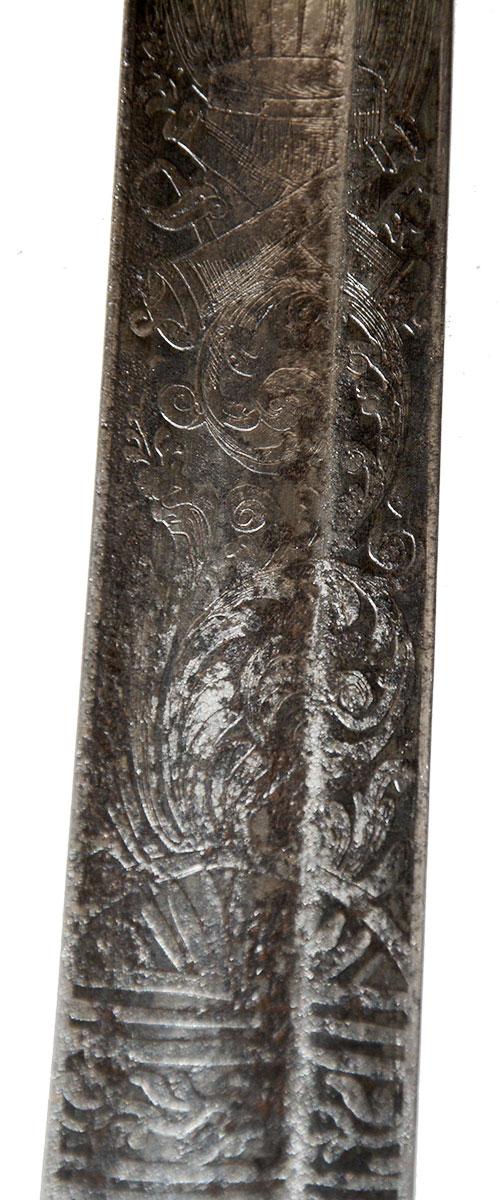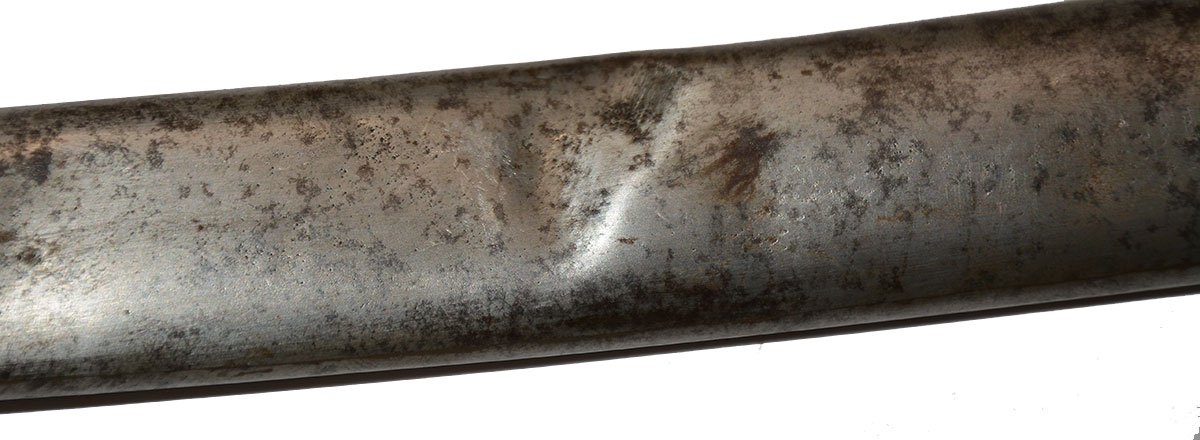site search
online catalog
IDENTIFIED HORSTMANN CAVALRY OFFICER’S SABER CARRIED BY GEORGE BRECK, NEW YORK LIGHT ARTILLERY

Hover to zoom



























$3,950.00 ON HOLD
Quantity Available: 1
Item Code: 490-5267
Cavalry officer’s sabers carried by officers in the light artillery are not uncommon, particularly in volunteer units where regulations might be more loosely applied, and a cavalry officer’s saber, offering better protection for the hand might be preferred. This one has an officer’s name engraved in script on the reverse of the knucklebow: “Lieut. Geo. Breck” in script, narrowing it to just two officers, both of whom served in New York batteries of light artillery as lieutenants and had good records: George Breck, Battery L, 1st NYLA; and George C. Breck, Battery B, 3rd NY Artillery. The lack of a middle initial in the inscription would tend to favor the former officer, but both had active service records that we summarize below along with the battery histories.
The saber is a Horstmann product, measuring 37-inches overall and has a 31-1/4-inch 1840 style blade stamped on the obverse ricasso with the king’s head mark of the Gebruder Weyersburg, indicating an import, and is etched above that with the retailer’s name, the well-known “W.H. HORSTMANN / & SONS / PHILADELPHIA.” See the relevant chapter in Thillmann, “Civil War Cavalry & Artillery Sabers” for details on both firms.The brass hilt is the standard three-branch form of a cavalry saber, with Phrygian cap pommel, slightly bell shaped, with leaf border and raised foliate elements inside and out on the branches as they near the guard. The entire hilt, including the grip, seems to have been lacquered at some point, likely as a preservative. The brass shows shows fairly bright, but does have some age stains, and sharkskin grip wrap shows a few wear spots, but largely good surface with nodes and gray color. The wire binding has a central twisted strand, bordered by a plain wire on either side, is slightly loose in places and may be a replacement as the blade pad is. The scabbard is good, plain steel with a screw at the throat typical of imports, and with rings, bands and drag in place. There are a few shallow dents near the drag. Overall it shows as a mottled, muted silver and dark gray, with some brown areas on the drag with some standing rust and some deeper pitting on the drag blade, all pretty consistent with real field use.
The blade is an 1840-style with flat back, 31 1/4” long with wide and narrow fullers, deeply etched on both sides with military and foliate motifs and the flat back edge carrying an etched leafy vine. The metal shows some shallow corrosion near the guard, but is largely smooth and a muted silver gray with some darker gray spots, the lower third somewhat darker on both sides, but with the etching visible throughout, on the lower portions showing as gray against a darker gray ground. The etched Horstmann blade address is rubbed, but visible. The Weyersburg mark is sharp. The blade has a good point and just a few small edge nicks, back somewhat from the point, about where the fuller runs out. The sword certainly shows field use. Interestingly, both George Brecks made 2nd Lieutenant in January 1862 and could have carried the sword until their muster out in 1865: George C. Breck as 2nd and 1st Lieutenant, and George Breck enrolling as a private, immediately making First Sergeant and then Lieutenant, Captain and later Brevet Major.
George Cuyler Breck enrolled at New York City at age 22 to serve three years and mustered in as Second Lieutenant Battery B 3rd New York Regiment of Artillery (Light) on Jan 18, 1862; as First Lieutenant Feb. 23, 1864., and mustered out with the battery July 13, 1865. He was also commissioned Captain July 5, 1865, with rank from Feb. 18, but not mustered. This Battery B was the second iteration of that company, the first having been consolidated with Companies C and E. It served in the 18th Corps in North Carolina from March 1862 and was converted into a light company in May 1862 and in the 10th Corps in South Carolina from January 1863. It saw action at Lovettsville, Va, in August 1862, Trenton Bridge, NC May 15, 1862; Rawles Mills, NC in November; the Goldsboro Expedition in December, with fighting at Southwest Creek, Kinston, Whitehall Bridge, and Goldsboro Bridge; at Sea Brook Island, SC, in June 1862; Morris Island, Battery Wagner, and the Siege of Battery Wagner in July; the bombardment of Ft. Sumter and other actions before Charleston; several actions on Johns Island, SC, in July 1864; Honey Hill, Coosawhatchie, Tillifinny Station, and Deveaux Neck S.C. in Nov.-Dec. 1864; Coles Island and Ashapoo, SC, in Jan. and Feb. 1865. George C. Breck died in 1869.
George Breck of Battery L 1st NYLA, had somewhat longer and more colorful service, commanding the battery at Gettysburg and, a prolific writer, chronicling much of the battery’s history in more than a hundred contemporary letters to newspapers back home. He had enrolled at Rochester, Sept. 17, 1861 and mustered into Co. L as a Private for three years on Oct. 25, but was made First Sergeant the next day, Oct. 26, and mustered in as 2nd Lieutenant three months later, on Jan. 28, 1862; First Lieutenant on July 31; and Captain a little under two years later, on May 27, 1864. He mustered out with the battery June 17, 1865, and was given a brevet as Major to date Aug. 1, 1864.
The battery had been the “Rochester Union Greys” and took in some members of the 1st Battalion Light Artillery, NYSM. They served in the Army of the Potomac, with brief stints in the Dept. of the Shenandoah and Pope’s Army of Virginia, then in the 1st Corps, 5th Corps, and Artillery Reserve Army of the Potomac, with brief service with the 9th Corps from Jan. 1865. They saw action with Pope in Virginia and were then in most of the major engagements of the Army of the Potomac, including Antietam, Chancellorsville, Gettysburg, Grant’s 1864 campaigns, Petersburg, etc. Breck was involved in placement of the battery’s monument at Gettysburg and died in 1925. [sr] [ph:L]
~~~~~~~~~~~~~~~~~~~~~~~~~~~~~~~~~~~
THIS ITEM, AS WITH ALL OTHER ITEMS AVAILABLE ON OUR WEB SITE,
MAY BE PURCHASED THROUGH OUR LAYAWAY PROGRAM.
CLICK HERE FOR OUR POLICIES AND TERMS.
THANK YOU!
Inquire About IDENTIFIED HORSTMANN CAVALRY OFFICER’S SABER CARRIED BY GEORGE BRECK, NEW YORK LIGHT ARTILLERY
Most Popular
Historical Firearms Stolen From The National Civil War Museum In Harrisburg, Pa »
Theft From Gravesite Of Gen. John Reynolds »
Selection Of Unframed Prints By Don Troiani »
Fine Condition Brass Infantry Bugle Insignia »
Large English Bowie Knife With Sheath 1870’S – 1880’S »
Imported (Clauberg) Us Model 1860 Light Cavalry Officer's Saber »
featured item
CONFEDERATE PASS SIGNED BY GEN. GEORGE PICKETT DURING THE GETTYSBURG CAMPAIGN; ALSO SIGNED BY MOXLEY SORREL (LONGSTREET’S AAG) AND WALTER TAYLOR (LEE’S AAG)
This document is handwritten on 7 ¾” x 6” lined paper, front and back. All is clearly legible though some of the ink is a bit faded. Three vertical and one center horizontal fold lines. Old tape repair along center horizontal fold on… (2025-1892). Learn More »


